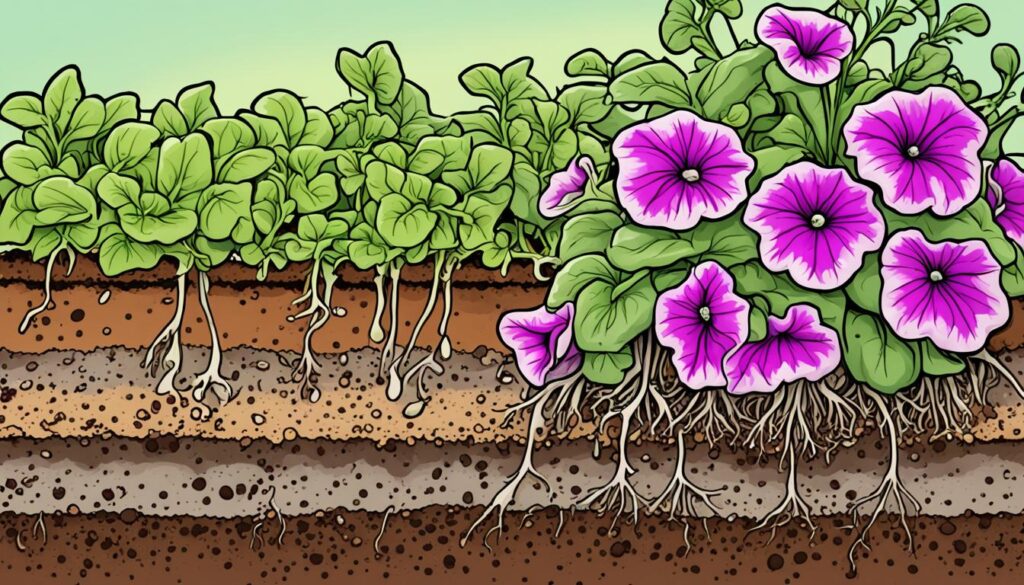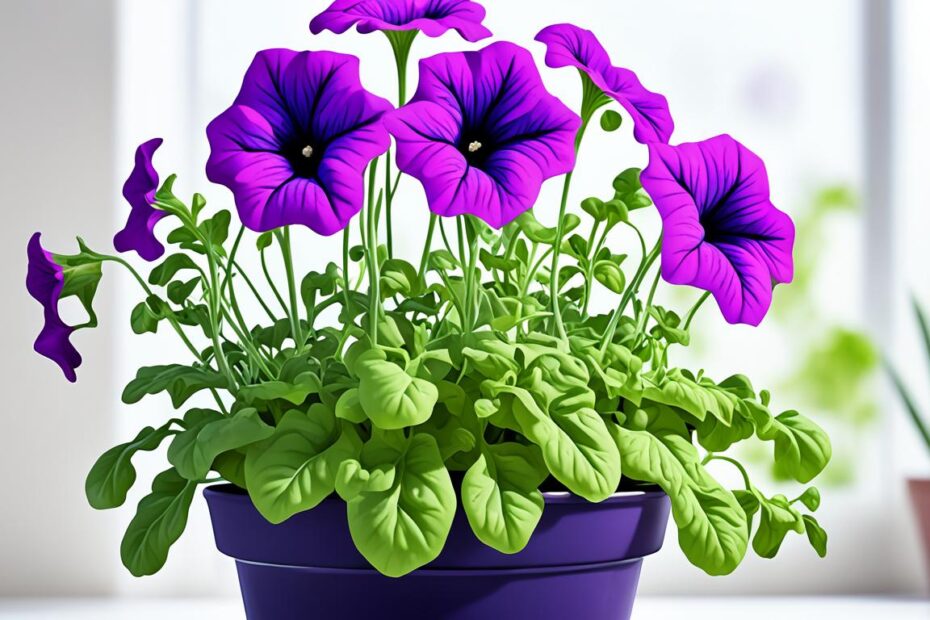Are you a petunia enthusiast wondering whether these beautiful flowers prefer acidic soil? The answer might surprise you. In this article, we will explore the relationship between petunias and acidic soil, uncovering the secrets to their thriving growth. Get ready to uncover the truth about this popular garden flower!
Key Takeaways:
- Petunias prefer well-draining soil with a pH level between 5.5 and 7.0.
- They should not be planted in heavy clay soils or overly moist soil.
- Using a good-quality potting mix or amending the garden soil with compost can improve drainage.
- Feed petunias regularly with a balanced fertilizer high in phosphorus and potassium for healthy growth.
- These beautiful flowers thrive in full sun, requiring at least six hours of direct sunlight per day.
Choosing the Right Soil for Petunias
Petunias are beautiful flowering plants that can add vibrant colors to your garden or container. To ensure their optimal growth, it is important to choose the right soil that meets their specific needs. Petunias thrive in well-draining soil that is slightly acidic, with a pH level ranging from 5.5 to 7.0. This allows them to absorb nutrients efficiently and prevents issues like root rot.
If your soil is heavy in clay or retains too much moisture, it is advisable to improve its texture and drainage. One way to achieve this is by using a good-quality potting mix that is rich in organic matter and nutrients. Another option is to amend your garden soil with compost or mulch, which will improve drainage while also providing additional nutrients.
Getting your soil tested can help you determine if any specific soil amendments are necessary to create the ideal growing conditions for petunias. Adding the right balance of amendments will ensure that your petunias get off to a strong start and thrive throughout the growing season.
Remember, petunias prefer a slightly acidic soil with good drainage:
• pH level: 5.5-7.0
| Soil Type | Drainage | pH Level |
|---|---|---|
| Well-draining soil | Good | 5.5-7.0 |
| Heavy clay soil | Poor | Above 7.0 |
| Moisture-retaining soil | Poor | Above 7.0 |

Feeding and Watering Petunias for Optimal Growth
If you want your petunias to thrive and produce beautiful blooms all season long, it’s important to provide them with the proper care. Feeding and watering are crucial components of petunia care that should not be overlooked. By following these guidelines, you can ensure that your petunias receive the nutrients and hydration they need to reach their full potential.
Feeding Petunias: Nourish for Health and Blooms
Feeding petunias plays a vital role in their overall health and flower production.
To provide your petunias with the essential nutrients they require, it is recommended to feed them every two weeks during the growing season. Choose a balanced fertilizer that is high in phosphorus and potassium, as these elements promote healthy root growth, strong stems, and abundant blooms. Look for a fertilizer specifically formulated for flowering plants or use a slow-release fertilizer to provide a steady supply of nutrients over time.
“Feeding petunias regularly with a balanced fertilizer high in phosphorus and potassium will result in healthy root growth, strong stems, and abundant blooms.”
Apply the fertilizer according to the package instructions, taking care not to over-fertilize as this can lead to excessive foliage growth at the expense of flower production. Use caution when applying fertilizer near the base of the plant to avoid burning the roots.
Watering Petunias: Deep and Targeted Hydration
Proper watering is key to maintaining the health and vigor of your petunias.
Petunias should be watered deeply but infrequently. Water them once the top layer of soil feels dry, typically about an inch down. This ensures that the roots receive adequate hydration without the risk of overwatering, which can lead to root rot and other problems. Avoid the temptation to water petunias too frequently, as this can also promote fungal diseases and damage the delicate blooms.

“Water petunias deeply when the top layer of soil feels dry, providing targeted hydration without overwatering.”
Drip irrigation or watering at the base of the plants is preferable to overhead watering, as it helps keep the foliage dry and reduces the risk of fungal diseases. If you’re growing petunias in hanging baskets or containers, be mindful that they may require more frequent watering due to their limited soil volume.
By carefully balancing feeding and watering, you can ensure that your petunias receive the optimal care they need to thrive. Remember, a well-fed and well-hydrated petunia plant will reward you with vibrant blooms that will enhance the beauty of your garden or container.
Deadheading and Sunlight Requirements for Petunias
Regular deadheading is essential to keep your petunias blooming all season long. By removing spent blooms and seed pods, you promote the growth of new blooms and prevent the plants from going to seed too quickly. This simple task not only maintains the aesthetic appeal of your petunias, but also encourages continuous flowering, ensuring a beautiful display in your garden or containers.
The Importance of Deadheading
Deadheading involves removing faded or wilted flowers from your petunias. When left unattended, these spent flowers can divert the plant’s energy towards seed production, rather than new growth and blooming. By deadheading regularly, you redirect the plant’s resources towards developing more beautiful and vibrant blooms.
Deadheading is a simple task that can be done by pinching off the faded flowers with your fingers or using a small pair of pruning shears. Aim to remove the entire flower head along with the seed pod behind it, ensuring a clean cut.
Tip: Deadheading should be performed every few days or as soon as the flowers start to fade. This diligent practice will ensure a continuous supply of colorful blooms throughout the season.
Sunlight Requirements for Petunias
Petunias thrive in full sun and require at least six hours of direct sunlight per day. Adequate sunlight is essential for their growth, blooming, and overall health. When selecting a location for your petunias, choose an area that receives ample sunlight and is sheltered from strong winds.
Tip: When growing petunias in containers, ensure you place them in a sunny spot, such as a south-facing balcony or patio. If you have limited sunlight in your garden, consider using hanging baskets or planters that can be positioned strategically to maximize sun exposure.
To further enhance your understanding of the sunlight requirements for petunias, refer to the table below:
| Light Levels | Description |
|---|---|
| Full Sun | Direct sunlight for at least 6 hours per day |
| Partial Sun | 3-6 hours of direct sunlight per day |
| Partial Shade | 3-6 hours of filtered sunlight or dappled shade per day |
| Full Shade | Less than 3 hours of direct sunlight per day |
By understanding and meeting the sunlight requirements for petunias, you can ensure healthy growth, abundant blooming, and vibrant colors throughout the growing season.
Conclusion
By following these petunia care tips, you can create a vibrant and beautiful garden full of these stunning blooms. Petunias thrive in slightly acidic, well-draining soil, so be sure to choose the right soil or amend it accordingly. Regular feeding with a balanced fertilizer and proper watering are crucial for their optimal growth and abundant blooms.
Don’t forget to deadhead your petunias regularly to encourage continuous blooming. Removing spent blooms and seed pods will promote the growth of new flowers, ensuring a stunning display throughout the season. Remember that petunias need at least six hours of direct sunlight per day, so finding a sunny spot in your garden or placing them in containers in a sunny location is essential.
Consider companion planting with marigolds, zinnias, and verbena to enhance the health of your petunias and deter pests. With the right care and attention, petunias can be a captivating addition to any garden or container. So, get ready to enjoy the beauty and colors of these wonderful flowers by following these petunia gardening tips!
FAQ
What type of soil do petunias prefer?
Petunias thrive in well-draining soil that is slightly acidic, with a pH level ranging from 5.5 to 7.0.
Can petunias tolerate heavy clay soils?
No, petunias should not be planted in heavy clay soils as they can lead to root rot and other issues.
How can I improve the drainage of the soil for petunias?
You can use a good-quality potting mix that is rich in organic matter and nutrients or amend the garden soil with compost or mulch to improve its texture and drainage.
How often should I feed my petunias?
It is recommended to feed petunias every two weeks during the growing season with a balanced fertilizer high in phosphorus and potassium.
How often should I water my petunias?
Petunias should be watered deeply once the top layer of soil feels dry. Hanging baskets and potted petunias may require more frequent watering.
Is deadheading necessary for petunias?
Yes, regular deadheading is essential to keep petunias blooming all season long. Removing spent blooms and seed pods promotes the growth of new blooms.
How much sunlight do petunias need?
Petunias thrive in full sun and require at least six hours of direct sunlight per day.
Can petunias be grown in containers?
Yes, petunias can be grown in containers, but it is important to place them in a sunny location.
